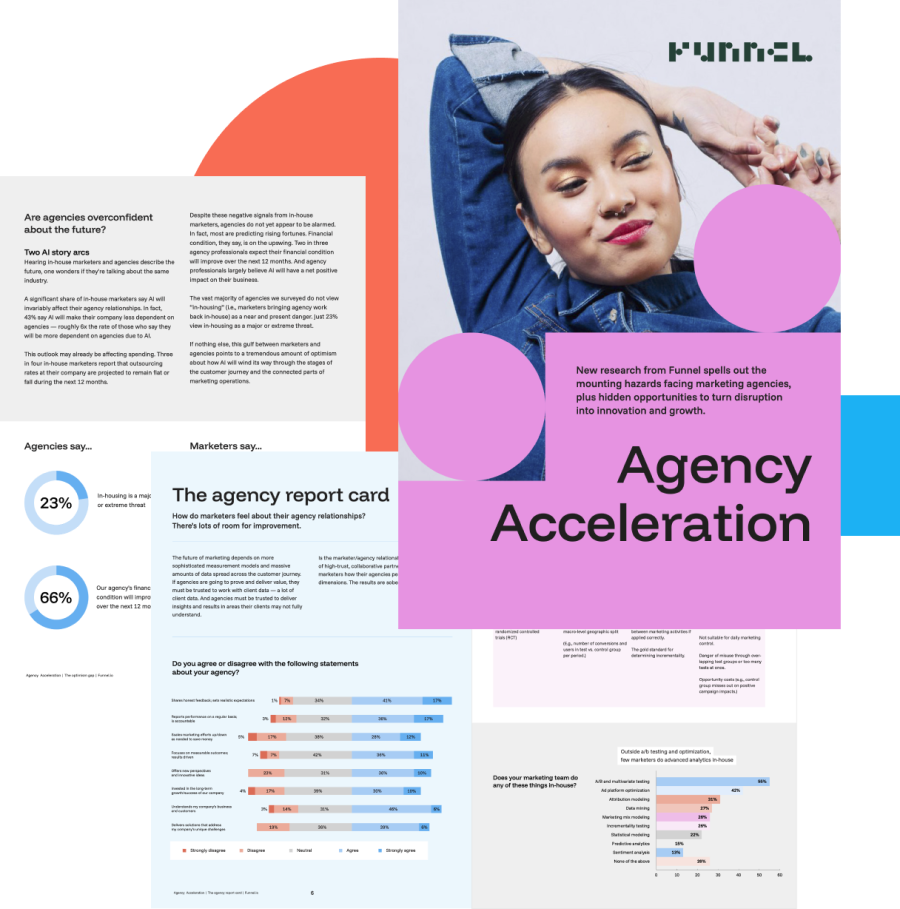-
 Written by Sean Dougherty
Written by Sean DoughertySenior Brand Creative at Funnel, Sean has more than 15 years of experience working in branding and advertising (both agency and client side). He's also a professional voice actor.
The traditional rivalry between in-house marketing teams and external agencies has taken a new turn.
Historically, external agencies dominated the field, largely due to their superior creative output, agility and speed. But that was the past.
The rising importance of first-party data and the rapid advancements in artificial intelligence have equipped in-house teams with new tools that could tilt the scales in their favor. So, let’s explore this internal-external rivalry a bit further to see who holds an advantage.

Click the button below to download your copy of Agency Acceleration and learn how agencies need to position themselves for the future.
Schedule your free demo
The traditional advantage of external agencies
For years, external agencies have been the go-to option for businesses seeking top-tier marketing services. And it’s not hard to see why.
External agencies often employ a wide array of creative talent, including designers, copywriters, strategists and niche specialists, who bring diverse perspectives and innovative ideas to the table. This diversity in thought and expertise often produces innovative new approaches and creative work.
Plus, external agencies are built for speed. After all, they base their entire business model around billable hours (whether they work from retainers or not). That means time is money, and the faster you can turn work around, the more revenue the agency can generate. This is also beneficial to their clients since they can quickly turn around projects, adapt to changes and scale their efforts up or down based on client needs.
As they grow and mature, many agencies specialize in specific industries, giving them a unique perspective of a client’s competitive landscape. They know what messaging and strategies are working right now. And for those agencies that work across multiple industries, they are able to learn from different business models and apply insights to clients in unique ways.
But changes in technology may be negating some of these advantages.
The rise of first-party data
One of the most significant shifts in recent years has been the growing importance of first-party data. This data, collected directly from a company's own sources (e.g., website analytics, CRM systems, purchase history), offers insights into customer behavior, preferences and needs.
While this data has always been valuable, marketers have increasingly turned to it in the face of growing privacy regulations. These laws (like GDPR and the CCPA) were introduced in response to growing concerns about the use of third-party data collected by companies that do not have a direct relationship with the consumer, often through tracking cookies and other means.
In turn, this made working with third-party data more difficult, causing the marketing industry to seek out better ways to track performance.
Why first-party data is the in-house edge
First-party data gives in-house teams a unique advantage since they operate within the confines of the business. While these marketers may still need to get approval from sales, business intelligence or IT teams to access that data, it’s much easier for them to achieve this than for external agencies — especially in industries that mandate extreme control over different data sets.
This direct and immediate access to data allows them to make data-driven decisions in real time. Plus this proximity to the data source eliminates many of the delays and communication barriers that external agencies might face when accessing and interpreting first-party data.
Let’s use an apparel company as an example. The in-house team can review CRM data alongside their performance marketing results and identify that their seasonal clothing sales are starting to slow down. As a result, they can quickly adjust their marketing allocation to stop running creatives promoting those seasonal items. An external agency won’t necessarily be able to access or monitor that data, thereby leaving them a bit more in the dark.
Empowered by AI
Artificial intelligence is another game-changer reshaping the marketing landscape. These tools and platforms are enabling in-house teams to enhance and extend their capabilities. For instance, they can now automate many routine tasks, uncover deep insights from complex data sets and even generate compelling creative material on their own.
AI-driven insights
It’s basically impossible for human beings to analyze huge volumes of data and identify deep patterns that are invisible during high-level reviews. But AI is great at it.
That means in-house marketers can use AI as an assistant to make sense of complex third- and first-party data to generate ideas for improvements. They can also start to predict customer needs, personalize experiences and optimize campaigns in ways that were previously unattainable.
For instance, AI can analyze customer interactions across multiple touchpoints and generate predictive models that forecast future behavior. This helps marketers tailor messages, recommend products or even adjust pricing strategies in real time, all based on their customer base's unique preferences and behaviors.
Automation and efficiency
Artificial intelligence also means automation. It helps marketers offload tons of manual processes (particularly around data management and analysis) so that they can focus on higher-value tasks. It also brings automation to the forefront, allowing in-house teams to streamline their operations and focus on higher-value tasks.
Consider the impact of AI-driven content creation tools like ChatGPT and MidJourney. These tools can generate personalized email content, social media posts and more based on predefined parameters and data inputs. This can turn small teams into content factories. (Though the quality of this machine-created content is still debatable.)
Can AI do it all?
According to our research, as many as 43% of in-house marketers say that AI will make their company less reliant on external agencies – roughly six times more than those marketers who say AI will make them more dependent.
Perhaps these marketers feel that they simply aren’t receiving the value promised by their agencies. In the same research, only 40% of marketers agreed that agencies are invested in the long-term growth of client businesses. Many marketers cited rinse-and-repeat tactics that don’t deliver.
It seems that in-house teams are ready to reduce their spend while feeling confident that they can get close enough to the creative output of external agencies with AI tools. Or, maybe the newly found freedom from automated tasks is giving these marketers the space to craft highly strategic and creative work.
Whatever the case, agencies should be on notice.
Are external agencies losing ground?
While the advantages of first-party data and AI are clear, does this mean that external agencies are losing their edge? Not necessarily. External agencies still offer several benefits that can complement in-house teams:
First, external agencies still benefit from being a bit removed from the daily grind in-house teams face. Thanks to the variety of business models they work with, they bring fresh perspectives to the table. Even against advanced AI and first-party data, this diverse experience still holds a ton of value.
They can also provide highly niche and specialized expertise that most businesses simply cannot afford to bring in house. Think of marketing agencies that specialize in advanced analytics. They can provide expert data analysts and measurement professionals at a fraction of the usual salary cost, since they can apply those talents across multiple accounts.
And when new expertise is needed quickly, it is far easier for agencies to scale (both up and down) than in-house teams.
However, the current landscape doesn’t necessarily mandate a zero-sum game. Instead, the key to success may be a strategic blend of in-house teams and external agencies that learn from and push each other.
A hybrid model for the win
Why not take the best of both worlds to create a marketing behemoth? A hybrid model allows companies to harness the power of first-party data and AI within their in-house teams while still benefiting from the creativity, expertise and scalability that external agencies provide.
In a hybrid model, in-house teams can take the lead on data-driven strategies and AI-powered insights, while external agencies contribute their creative expertise and industry knowledge. This collaborative approach ensures that marketing efforts are both highly personalized and creatively engaging.
For example, an in-house team might use AI to segment their audience and identify key customer personas. They could then work with an external agency to develop targeted campaigns that speak directly to these personas, combining data-driven insights with creative storytelling. Cool, right?
Shared technology platforms
Another advantage of the hybrid model is the ability to share technology platforms between teams. Using common tools and systems allows both parties to collaborate more effectively, ensuring that data flows seamlessly and campaigns are aligned with overall business objectives.
This shared technology infrastructure also enables better measurement and reporting.
A new era of marketing collaboration
The rise of first-party data and AI has undoubtedly shifted the balance favoring in-house marketing teams. These teams now have the tools to rival the capabilities of traditional external agencies. However, the true power of these advancements lies in the potential for collaboration. And don’t forget, agencies have access to these same AI tools. \
By embracing a hybrid model that combines the strengths of both in-house and external teams, companies can create marketing strategies that are both data-driven and creatively compelling.
In this new marketing era, the question is not whether in-house teams hold an advantage over external agencies, but how these two forces can work together to achieve the best results. The future of marketing belongs to those who can master the art of collaboration, leveraging the full potential of first-party data, AI and creative expertise.
-
 Written by Sean Dougherty
Written by Sean DoughertySenior Brand Creative at Funnel, Sean has more than 15 years of experience working in branding and advertising (both agency and client side). He's also a professional voice actor.
